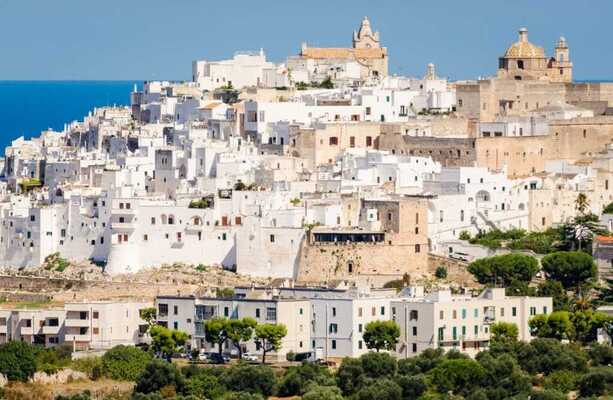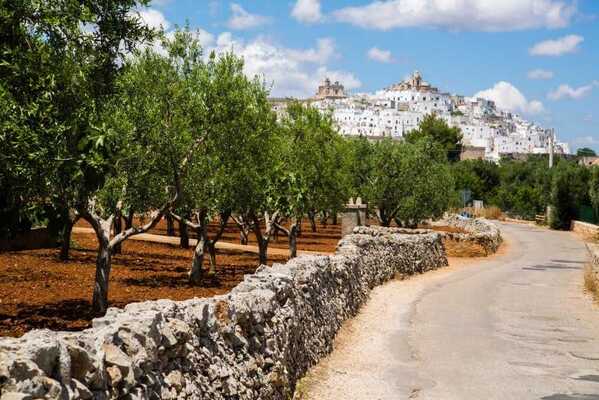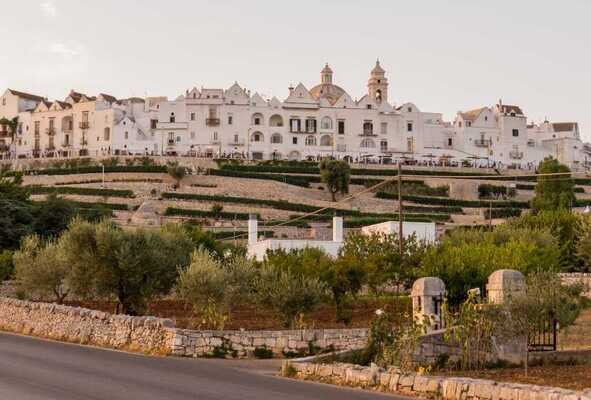Cisternino
Anyone who finds themselves visiting the Itria Valley cannot miss what is considered one of the most beautiful medieval villages in Italy: Cisternino. A set of white houses, alleys and small squares that recall times gone by, but also architectural works and churches to admire during your walks around the town.

What to see in Cisternino
Walking around the beautiful Cisternino you come across Piazza Garibaldi and, in particular, the Villa Comunale and the Torre Grande, a quadrangular structure from the Norman and Frederick era, an ancient lookout point from which you can enjoy a beautiful panorama (the Belvedere). Near these buildings there is Porta Grande, a gate that leads to the historic center and the Mother Church, in honor of San Nicola, from the Romanesque era, inside which a Renaissance work is preserved, the Madonna with child, created by Stefano di Putignano in 1517.
The peculiarity of Cisternino is that every alley and street has something to tell: during your walk you will certainly come across Via Santa Maria di Costantinopoli where it will be possible to admire the panel painting “Madonna of the carpenter” and a remainder of a fresco portraying the Virgin. The typical architecture of the houses is fascinating: small white buildings huddled together, particular for their balconies or stone masks. However, there is no shortage of more important palaces such as that of the Governor, Palazzo Cenci, Palazzo Lagravinese and Palazzo Pepe. Even the main street, Corso Umberto I, is characterized by a group of white houses, each beautiful in some small detail: all to be admired and photographed as they are enriched with decorations and flowers.
Cisternino is not only beautiful to visit during the day but also in the evening, especially in summer when, in the alleys of the historic center or in Piazza Vittorio Emanuele, the clubs are full of people sipping cocktails or having fun with live music and DJs set.

The traditions of Cisternino
Just outside the town there is the Sanctuary of the Madonna d’Ibernia, where Easter Monday is celebrated: during this holiday, the people of the town go to the Sanctuary with a typical dessert called “u churruchele“, a symbol of prosperity , made in the shape of a bag with two boiled eggs for boys and in the shape of a doll with a boiled egg for girls.
Another very heartfelt festival is the one in honor of Sant’Antonio, whose celebrations begin on January 17th or, again, the patronal festival in honor of the patron saints Quirico and Giulitta, on the first Sunday of August when processions, concerts and fireworks. Finally, not far from Cisternino, in the Caranna area, the Orecchiette Festival is held which attracts the locals to get together with dancing, popular music and good food.
What to eat
Cisternino is a lovely little village where you can still breathe the familiar air of the past: you can in fact taste excellent typical products or traditional dishes in characteristic farms or welcoming taverns and restaurants. Among the typical products to taste, an undisputed protagonist is meat: beef sausages, bombette (pork meat rolls filled with canestrato cheese, salt and pepper) and gnummeredde (based on lamb offal). These products can be enjoyed in the typical butchers-restaurants of the historic center, the famous “ready-to-eat stoves” where you can choose the cut of meat you prefer and enjoy it directly at the tables in front of the butcher’s shop, accompanied by an excellent glass of wine. Another unmissable dish typical of the Apulian tradition is orecchiette with turnip greens or with sauce and pecorino or broad beans and chicory. Again, a typical snack is friselle, often seasoned with tomatoes, oil, salt and oregano.
Cisternino’s desserts are also an absolute must-try, especially if you are a lover of almonds, one of the fixed ingredients in these preparations: sugar almonds (menule atterrete), i.e. toasted almonds sprinkled with sugar; castagnelle, small loaves made with flour, eggs, sugar, almonds, cinnamon and cloves or, again, the variant with the addition of black cherry called castagnama. Another dessert is the Santantonio, a rectangular biscuit prepared with flour, eggs, sugar and almonds, excellent to accompany coffee or tea. Other typical dairy biscuits, Rombò, are those made with flour, eggs, sugar, hazelnuts and milk, also excellent at the end of a meal to accompany a glass of rum.
How to reach Cisternino
Cisternino is located in the Itria Valley and it is possible to get there:
- by plane, the closest airport is Brindisi (50 km) or Bari (80 km), from which it will then be necessary to take a rental car or a transfer to reach Cisternino.
- by train. Coming from the North the fastest solution is to take a Regional train from Bari. Alternatively there are other solutions from Brindisi, Ostuni, Polignano a Mare etc, we therefore recommend consulting the Trenitalia website.
- by car, for those coming from the North you need to exit at Bari Nord, then continue on the SS16 towards Brindisi and then follow the signs for Cisternino to get onto the SS379. For those coming from the South, however, the motorway exit is Brindisi-Lecce, so it will be necessary to follow the signs for SS16 towards Bari and then those for Cisternino.

Ostuni: the “white city”
Picturesque and renowned tourist destination, it boasts a medieval village with winding streets and whitewashed houses. Divided between the old city known as the "land" and the more recent "marina" one, it offers evocative views of stairways, alleys and small squares overlooked by shops, small shops and typical restaurants.

Itria Valley
In this large and flat karst basin, in which the trulli, the verdant countryside, carefully cultivated with vineyards, vegetable gardens, fruit trees, the dry stone walls, the tiny country lanes contribute to the definition of a pleasant and fascinating landscape picture.

Locorotondo – among the most beautiful village in Puglia
Locorotondo, a small Apulian village where you can get lost in the alleys of the historic center admiring the characteristic houses with sloping roofs and centuries-old churches.
